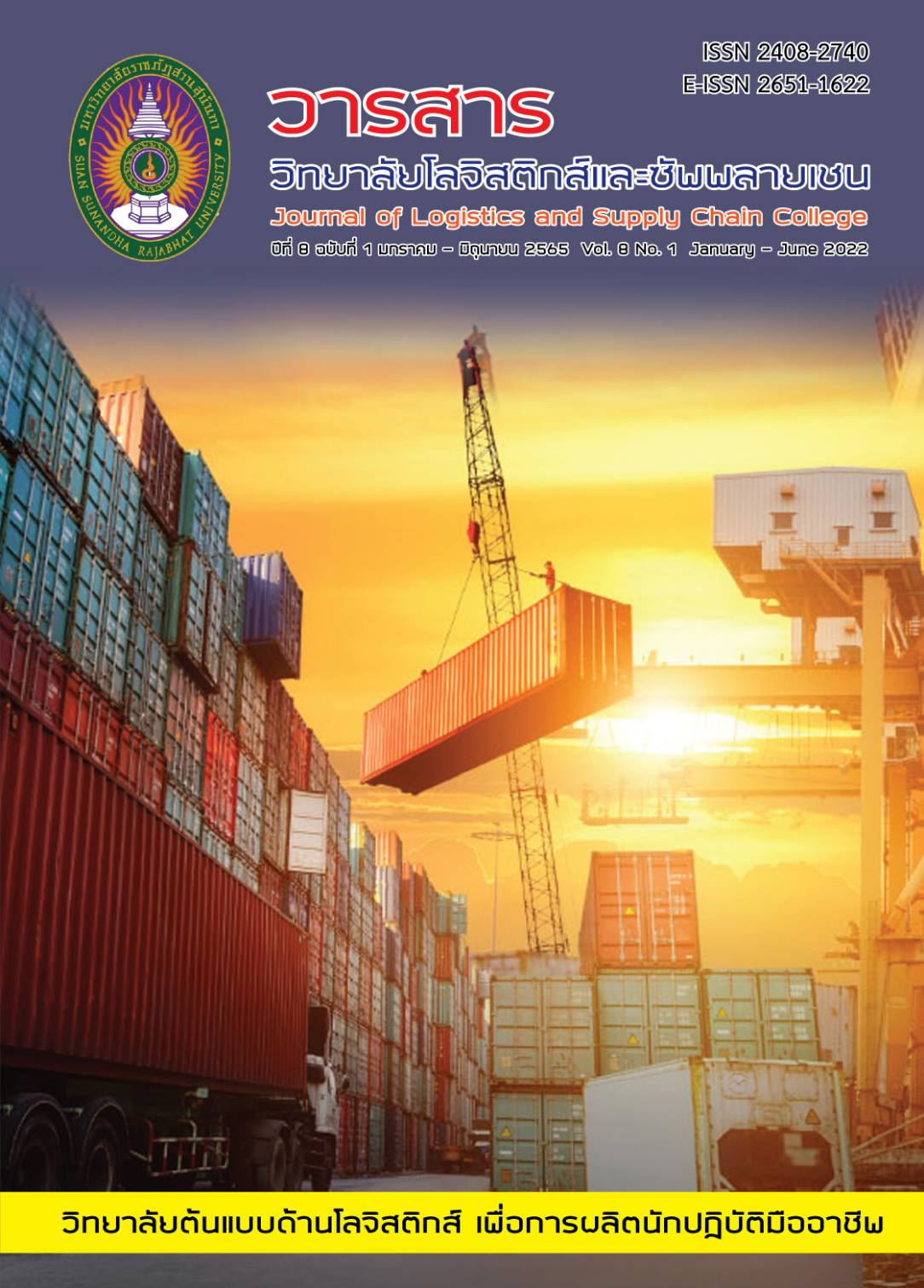An Improvement Guideline for Chilli’s Supply Chain in Muang Samsip District,Ubon Ratchathani Province
Keywords:
Chili, Supply Chain, Muang Samsip district, Ubon Ratchathani provinceAbstract
This research aimed to 1) study the chilli supply chain in Muang Samsip district, Ubon Ratchathani province and 2) study problems and improvement guidelines that occurred in the upstream and middle stream of chilli supply chain. Qualitative research methodology was used and 30 chilli farmers and 8 collectors from a population of 1,056 were considered as samples. The research instrument was a semi-structured interview form that tested the quality by checking the appropriate languages and contents. The data were obtained from the in-depth interview and analyzed by descriptive statistics including frequency and percentage. The study result revealed that 1) the chilli supply chain model in Muang Sam Sip district, Ubon Ratchathani province; it consists of upstream part which was chilli farmers, the middle stream which was chili collectors, and downstream segments are the wholesaler and retailer markets as well as product processing plants. 2) Problems and solutions arising in the upstream and midstream supply chains of chilli. It was found that there was a problem in production planning and forecasting. It includes the cost problem of chilli collectors. This could be solved by developing relationships between farmers and collectors, which would require more cooperation and exchanging of information.
References
ชยากร พุทธกําเนิด, นคร ไชยวงศ์ศักดา, ขวัญเรือน สินณรงค์, นิศารัตน์ ไชยวงศ์ศักดา, ธัญพร ฟุ้งเฟื่อง และสุทธดา ขัตติยะ. (2563). การจัดการการตลาด การผลิต และโซ่อุปทานการปลูกกล้วยหอมของกลุ่มเกษตรกร ป่าตึง - ริมกก อําเภอเมือง จังหวัดเชียงราย. วารสารวิทยาลัยโลจิสติกส์และซัพพลายเชน. 6(2), 45-59.
ชัยวัฒน์ ใบไม้ และศิริรัตน์ ตรงวัฒนาวุฒิ. (2561). การปรับปรุงประสิทธิภาพการผลิตของโรงสีข้าวอินทรีย์ขนาดเล็กในจังหวัดเชียงใหม่ จากการวิเคราะห์ด้วยตัวแบบ SCOR. วารสารวิชาการคณะบริหารธุรกิจ มหาวิทยาลัยเทคโนโลยีราชมงคลธัญบุรี.13(1), 123-138.
ทิพวรรณ มานนท์, จินันทนา จอมดวง และอารยะ วรามิตร. (2554). กลยุทธ์ป้องกันกําจัดโรคแมลงศัตรูพริกโดยเกษตรกรมีส่วนร่วม : เพื่อเพิ่มรายได้และความมั่นคงอาหาร. วารสารมหาวิทยาลัยทักษิณ, 14(3) พิเศษ, 30-39.
ประไพพิมพ์ สุธีวสินนนท์ และประสพชัย พสุนนท์. (2559). กลยุทธ์การเลือกตัวอย่างสำหรับการวิจัยเชิงคุณภาพ. วารสารปาริชาต มหาวิทยาลัยทักษิณ. 29(2), 31-48.
พจน์ เดชเกิด และปณัทพร เรืองเชิงชุม. (2562). ความสูญเปล่าจากการไหลของข้อมูลสารสนเทศภายใต้ห่วง โซ่อุปทานในกระบวนการผลิตยางแผ่นรมควันและยางแผ่นรมควันอัดก้อน กรณีศึกษา สถาบันเกษตรกรในพื้นที่ภาคใต้. วารสารวิทยาลัยโลจิสติกสและซัพพลายเชน, 5(2), 4-18.
มลฑา สมบุญตนนท์, เออวดี เปรมัษเฐียร และกาญจนา ศรีพฤทธิ์เกียรติ. (2562). การดำเนินงานและส่วนเหลื่อมทางการตลาดของห่วงโซ่อุปทานผักไฮโดรโปนิกส์. วารสารปัญญาภิวัฒน์, 11(2), 147-161.
มลฤดี จันทรัตน์ และวิวัฒน์ ไม้แก่นสาร. (2562). การวิเคราะห์โซ่อุปทานส่วนต้นน้ำของข้าวสังข์หยดเมืองพัทลุงด้วย SCOR Model. วารสารปัญญาภิวัฒน์, 11(1), 127-138.
มุกธิดา ขำมี และจีราพร ทิพย์พิลา. (2563). ผลการให้ความรู้ด้านความปลอดภัยในการใช้สารเคมีกำจัดศัตรูพืชของเกษตรกรผู้ปลูกพริกบ้านนาเยีย ตำบลไร่น้อย อำเภอเมือง จังหวัดอุบลราชธานี. วารสารการแพทย์และสาธารณสุข มหาวิทยาลัยอุบลราชธานี, 3(1), 13-24.
ยุทธกร ฤทธิ์ไธสง, เอกรัตน์ เอกศาสตร์, เบญจมาศ อภิสิทธิ์ภิญโญ และสุวิมล ตั้งประเสริฐ. (2561). การปรับปรุงประสิทธิภาพห่วงโซ่อุปทานข้าวหอมมะลิทุ่งสัมฤทธิ์เพื่อเพิ่มขีดความสามารถในการแข่งขันของสหกรณ์การเกษตรพิมาย อําเภอพิมาย จังหวัดนครราชสีมา. วารสารวิชาการบริหารธุรกิจ สมาคมสถาบันอุดมศึกษาแห่งประเทศไทย, 7(1), 123-145.
วัชรพจน์ ทรัพย์สงวนบุญ และปรียากมล เอื้องอ้าย. (2562). แนวทางการประยุกต์ใช้กระบวนการซัพพลายเชนตามแบบจําลองอ้างอิงการดําเนินงานซัพพลายเชนกรณีศึกษาบริษัทมหาชนแห่งหนึ่งในประเทศไทย. วารสารการจัดการธุรกิจ มหาวิทยาลัยบูรพา, 8(2), 89-102.
วัชรา จินตา และกัมปนาท วงษ์วัฒนพงษ์. (2564). การศึกษาความคิดเห็นของผู้ประกอบการภาคเกษตรกรรมในการจ้างแรงงานต่างด้าวที่มีสัญชาติพม่า กรณีศึกษาอําเภอแม่สอด จังหวัดตาก. Journal of Modern Learning Management, 6(2), 75-85.
วีรวัฒน์ คำภู และชาญชัย นามพล. (2563). การพัฒนาแอ็ปพลิเคชันการเปรียบเทียบราคาขายมันสำปะหลังต่อผู้รับซื้อในเขตอำเภอน้ำยืน จังหวัดอุบลราชธานี บนระบบปฏิบัติการแอนดรอยด์. วารสารเทคโนโลยีอุตสาหกรรม มหาวิทยาลัยราชภัฏอุบลราชธานี, 10(2), 37-48.
เศรษฐภูมิ เถาชารี, พัฐสุดา ชูติกุลัง, จิรวัฒน์ ตั้งจิตโสมนัส, จิรวดี อินทกาญจน์ และกนกนาฏ หาญสิทธิพร. (2561). ผลการวัดประสิทธิภาพโซ่อุปทานข้าวแบบหลายวัตถุประสงค์ ในเขตภาคกลางของประเทศไทย. วารสารวิชาการ วิศวกรรมศาสตร์ ม.อบ., 11(2), 25-40.
สุภาวดี ขุนทองจันทร์. (2559). ต้นทุนผลตอบแทนของเกษตรกรผู้ปลูกพริกพื้นเมืองหัวเรือในเชิงเศรษฐกิจและสังคม. วารสารมหาวิทยาลัยศิลปากร ฉบับภาษาไทย, 36(3), 169-185.
สำนักงานเกษตรจังหวัดอุบลราชธานี. (2564). ข้อมูลการผลิตพืชผัก พ.ศ.2563. อุบลราชธานี : สำนักงานเกษตรจังหวัดอุบลราชธานี.
Dissanayake, C. K., & Cross, J. A. (2018). Systematic mechanism for identifying the relative impact of supply chain performance areas on the overall supply chain performance using SCOR model and SEM. International Journal of Production Economics, 201, 102–115.
Koberg, E., & Longoni, A. (2019). A systematic review of sustainable supply chain management in global supply chains. Journal of Cleaner Production, 207, 1084–1098.
Lima-Junior, F. R., & Carpinetti, L. C. R. (2019). Predicting supply chain performance based on SCOR® metrics and multilayer perceptron neural networks. International Journal of Production Economics, 212, 19–38.
Müller, J. M. (2019). Contributions of Industry 4.0 to quality management - A SCOR perspective. IFAC-PapersOnLine, 52(13), 1236–1241.
Tridge. (2021). Chili pepper global production and top producing countries. Retrieved 5 April 2021, From: https://www.tridge.com/intelligences/other-chili-pepper/production.



